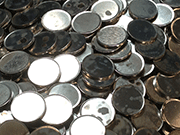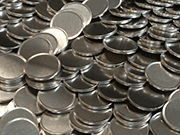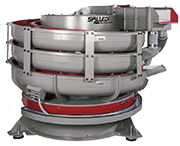E-Archive
Good Vibrations
in Vol. 15 - November Issue - Year 2014
Mass Finishing and Washing

Coin blanks after annealing without BFTF de-oiling

Coin blanks after annealing with previous BFTF de-oiling

Production process of coin blanks

Blank Finishing Through Feed System BFTF 10
Mass Finishing techniques are often well known in classical fields of applications. Edge-Breaking, grinding, polishing, radiusing and deburring are common and widely spread applications of mass finishing technologies in modern industries all over the world. Nevertheless, there are also quite different possibilities to use mass finishing equipment. Some of them are included in more or less researched technologies or processes, some of them may still be largely unknown.
One example of such a special modification of slide grinding machines is to coat parts with additives that should adhere to the surface. Often, finishing machines are used to coat parts if the additive is not easy to bring onto a possibly complex surface and if the contact between surface and additive has to be established repeatedly in order to reach a certain degree of lining onto the surface. In such cases, often no media except the additive is used in the machine and the motor is adjusted to a minimum power, just enough to maintain part flow and mix.
The opposite target of removing something from the surface is a little bit more common. Sometimes, certain layers from preceded production steps like hardening oxide layers have to be removed. More often - for example in the minting industry - oil has to be removed from the surface. In this case, it is possible to use a vibratory finishing machine like a grinding machine with integrated washing effects in one unit.
Oil is often used with machine tools and to protect metal within the chain of production. However, oil can also have disastrous effects for certain single production steps and threatens the quality which could be achieved by that production step. In the minting industry for example, oil is used to form blanks out of the metal strip, so after the punching of the coin blanks, the surface is covered with oil. The next step for bringing the coin into shape would be the rimming of the coin. After that step, annealing of the coin blanks follows. In this process, extreme heat kicks off a chemical reaction between the oil and other residues on the coin’s surface, resulting in stains on the surface.
These unwanted residues have to be handled again in the following step of surface finishing of which the main target should exclusively lay in the polishing of the surface, not just in removing residues from the surface. Loaded with such extra work, the surface finishing process has to be more complex, which means also lengthier and more resource-hungry.
The trick now can be to insert a surface-washing step between punching and rimming of the coins. This would be made possible by a simple round tub mass finishing vibrator, if you do not consider any automation, but because today the automation of the coin production chain is a matter of course, only a fully automatic flow-through vibratory system like the Spaleck BFTF 10 is an option. This equipment is especially constructed to be used to finish coins and remove oil from their surface. In this case, very mild abrasives and large amounts of fluid are used to optimize the coins for the next step of rimming, and special additives are used to clean the coin surface of any residues for the following annealing process with their extremely high temperatures.
This modification of a classic surface finishing machine has different impacts on the overall process. On the one hand, the quality problems after the annealing step are solved. On the other hand, the surface finishing process can be focused totally on its main target to polish the coin blank surface in order to optimize coin quality and in order to maximize the lifetime of the expensive die stamps.
However, it has a further interesting effect. Because the surface finishing process is now shorter and exempt from its previous load of coping with bad spots on the blank’s surface, it can be designed more economically and with less resources of energy, water and chemical additives.
In this project case, raising the final product quality with a modified surface finishing machine means also saving financial and environmental resources, so the knowledge-gathering process of finding "good vibrations" is always not just an effort of continuous engineering improvement of existing construction concepts but a steady search for new process concepts as well.
Good Vibrations
by Mathieu Geuting
Spaleck Oberflächentechnik GmbH & Co. KG, Germany
Tel. +49.2871.9500 14
Fax +49.2871.9500 95
E-mail: m.geuting@spaleck.biz



























